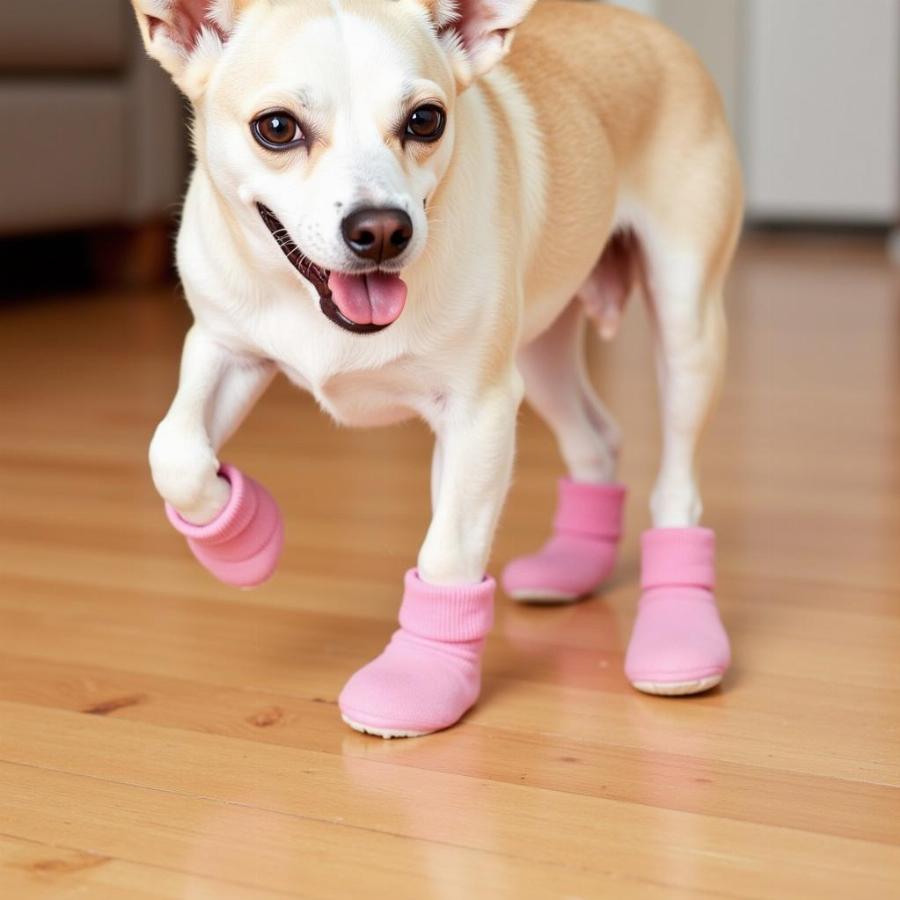Dog booties for traction are becoming increasingly popular among dog owners. But why are they necessary and what benefits do they offer for your furry friend? Whether you’re dealing with icy sidewalks, hot pavement, or rough terrain, dog booties provide essential protection and support for your dog’s paws.
Why Traction Matters: Protecting Those Precious Paws
Dogs’ paws are tough, but they’re not invincible. Just like our feet need protection, your dog’s paws can benefit from an extra layer of defense, especially when encountering challenging conditions.
Here’s why traction is so crucial:
- Extreme Temperatures: Hot pavement in the summer can burn delicate paw pads. In the winter, ice and snow can cause cracking, dryness, and even frostbite. Dog booties for traction provide insulation and create a barrier against these extreme temperatures.
- Sharp Objects: Broken glass, thorns, sharp rocks, and debris pose a constant threat to your dog’s paws, particularly on hikes or walks in unfamiliar areas. Booties act as a shield, preventing cuts, punctures, and infections.
- Chemicals and Irritants: Sidewalks and roads are often treated with salt, de-icers, and other chemicals during the winter months. These substances can irritate your dog’s paws and may even be toxic if ingested while licking. Booties offer a barrier against these harsh chemicals.
- Improved Traction: Slippery surfaces like ice, hardwood floors, and wet tiles can be challenging for dogs to navigate, leading to slips and falls. Dog booties with textured soles provide enhanced grip and stability, reducing the risk of injuries.
Choosing the Right Booties: Finding the Perfect Fit
Selecting the appropriate dog booties for traction is essential for ensuring your furry friend’s comfort and safety.
Consider these factors:
- Size and Fit: Ill-fitting booties can rub, cause discomfort, and even fall off. Measure your dog’s paws carefully and consult sizing charts provided by manufacturers.
- Material: Booties are available in various materials, including waterproof fabrics, leather, and rubber. Consider the weather conditions and intended use when choosing a material.
- Sole Type: For maximum traction on slippery surfaces, opt for booties with textured or rubberized soles.
- Closure Type: Look for secure closures like Velcro straps or buckles to prevent the booties from slipping off during activities.
- Visibility: If you frequently walk your dog during low-light conditions, choose booties with reflective strips to enhance visibility and safety.
“A well-fitted bootie should feel snug but not too tight,” advises Dr. Emily Carter, a veterinarian specializing in canine sports medicine. “You should be able to slip two fingers comfortably between the bootie and your dog’s paw.”
Getting Your Dog Accustomed to Booties
Introducing dog booties to your furry friend requires patience and positive reinforcement.
Follow these tips:
- Start Slowly: Begin by letting your dog sniff and investigate the booties.
- Positive Association: Pair the booties with treats, praise, and playtime to create a positive connection.
- Gradual Introduction: Put the booties on for short periods and gradually increase the duration.
- Reward Progress: Offer plenty of praise and rewards when your dog walks confidently in their booties.
- Be Patient: Some dogs adjust quickly, while others may need more time.
 Dog wearing booties indoors
Dog wearing booties indoors
Beyond Traction: Other Benefits of Dog Booties
Dog booties offer more than just traction.
- Allergy Protection: For dogs with environmental allergies, booties can help prevent allergens from coming into contact with their paws.
- Wound Protection: If your dog has a cut or injury on their paw, booties can help keep the wound clean and protected during healing.
- Support for Senior Dogs: Older dogs with mobility issues can benefit from the added support and stability that booties provide.
Dog Booties: A Pawsitive Choice
Dog booties for traction are a valuable investment for any dog owner looking to provide extra paw protection and enhance their furry companion’s safety and comfort. From navigating icy sidewalks to exploring rough terrain, booties offer a range of benefits.
Remember to choose the right size and type of booties for your dog’s needs and introduce them gradually with positive reinforcement. By taking these steps, you can help your canine companion enjoy many happy and safe adventures, no matter the weather or terrain.
FAQs about Dog Booties for Traction
Q: Do dog booties really work?
A: Yes, dog booties, especially those with textured soles, can significantly improve traction on slippery surfaces, like ice, hardwood floors, and wet tiles. They provide better grip, reducing the risk of slips and falls.
Q: Are dog booties cruel?
A: No, dog booties are not cruel if they fit properly and are used appropriately. Ill-fitting or improperly used booties can cause discomfort. Always choose the correct size and introduce them gradually to your dog.
Q: How do I clean dog booties?
A: Most dog booties can be hand-washed with mild soap and water. Allow them to air dry completely before using them again.
Explore More Paw-some Tips!
- Learn about dog shoes jordans for a stylish and functional option.
- Discover the best dog beach key west for safe and fun-filled adventures.
- Find out why your dog can not walk on wood floors and how to address it.
Beaut Dogs is your trusted source for all things dog-related. For personalized advice and expert tips on choosing the perfect dog booties for traction, don’t hesitate to contact us at [email protected]. We’re here to help you keep your furry friend happy, healthy, and safe.